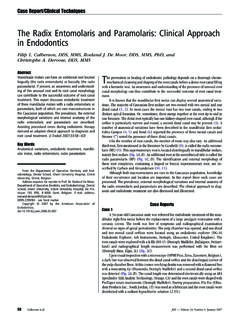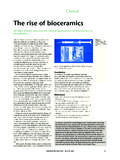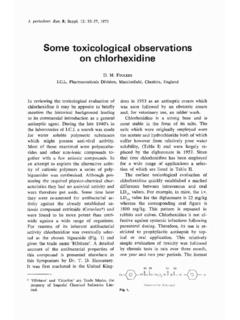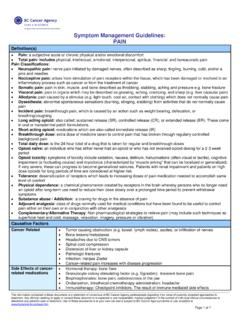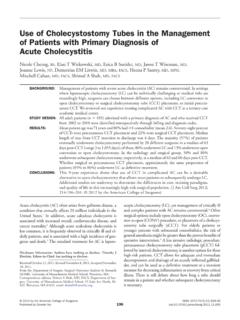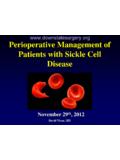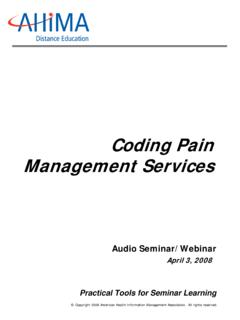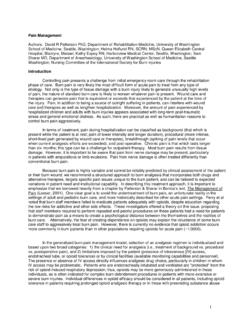Transcription of Combining Paracetamol (Acetaminophen) with …
1 pain MedicineSection Editor:Spencer S. LiuCombining Paracetamol ( acetaminophen ) withNonsteroidal Antiinflammatory Drugs: A QualitativeSystematic Review of Analgesic Efficacy for AcutePostoperative PainCliff K. S. Ong, PhD,* Robin A. Seymour, PhD, Phillip Lirk, MD, and Alan F. Merry, MBChB, FANZCA, FPMANZCA, FRCA BACKGROUND:There has been a trend over recent years for Combining a nonsteroidalantiinflammatory drug (NSAID) with Paracetamol ( acetaminophen ) for pain management. How-ever, therapeutic superiority of the combination of Paracetamol and an NSAID over either drugalone remains controversial. We evaluated the efficacy of the combination of Paracetamol and anNSAID versus either drug alone in various acute pain :A systematic literature search of Medline, Embase, Cumulative Index to Nursing andAllied Health Literature, and PubMed covering the period from January 1988 to June 2009 wasperformed to identify randomized controlled trials in humans that specifically comparedcombinations of Paracetamol with various NSAIDs versus at least 1 of these constituent studies were stratified into 2 groups: Paracetamol /NSAID combinations versusparacetamol or NSAIDs.
2 We analyzed pain intensity scores and supplemental analgesicrequirements as primary outcome measures. In addition, each study was graded for quality usinga validated :Twenty-one human studies enrolling 1909 patients were analyzed. The NSAIDs usedwere ibuprofen (n 6), diclofenac (n 8), ketoprofen (n 3), ketorolac (n 1), aspirin(n 1), tenoxicam (n 1), and rofecoxib (n 1). The combination of Paracetamol and NSAIDwas more effective than Paracetamol or NSAID alone in 85% and 64% ofrelevant studies,respectively. The pain intensity and analgesic supplementation was and lesser, respectively, in the positive studies for the combination versus Paracetamol group, and lesser, respectively, in the positive studies for the combinationversus the NSAID group. No statistical difference in median quality scores was found betweenexperimental :Current evidence suggests that a combination of Paracetamol and an NSAID mayoffer superior analgesia compared with either drug alone.
3 (Anesth Analg 2010;110:1170 9)Different classes of analgesics exert their effectsthrough different mechanisms. Their side effects( , respiratory depression with opioids or enter-opathy with nonsteroidal antiinflammatory drugs [NSAIDs])tend to bedifferent and may be dose related. A combi-nation of analgesics from different classes may provideadditive analgesic effects with fewer side effects thanwhen a single therapeutic drug is used. There has been atrend over recent years for Combining NSAIDs withparacetamol ( acetaminophen ) for the management ofacute postoperative pain ,1,2but the therapeutic superior-ity of the combination over either drug alone ,4In 2002, Hyllested et thatparacetamol/NSAID combinations showed superiorpain relief over Paracetamol alone in 5 of 7 studies, butover an NSAID alone in only 2 of 4 studies, whereasR msing et an advantage for such combina-tions over Paracetamol alone in 6 of 9 studies but over anNSAID alone in only 2 of 6 studies.
4 These authors notedthat relevant studies were sparse. We have updated thesereviews to include randomized controlled trials (RCTs)published since then with the aim of evaluating whetherparacetamol/NSAID combinations provide superior ef-ficacy in the treatment of acute postoperative pain toeither drug IN HUMAN CLINICAL STUDIES FOR THEUSE OF Paracetamol /NSAID COMBINATIONSWe aimed to determine whether Paracetamol /NSAID com-binations provide superior efficacy in the treatment ofacute postoperative pain to either drug the *Department of Oral & Maxillofacial Surgery, Faculty of Dentistry,National University of Singapore, Republic of Singapore; School of DentalStudies, University of Newcastle Upon Tyne, UK; Department ofAnesthesiology and Critical Care Medicine, Innsbruck Medical Univer-sity, Innsbruck, Austria; and Department of Anaesthesiology, Univer-sity of Auckland, Auckland, New for publication November 12, by a grant from AFT Pharmaceuticals Ltd, level 2, 9 Anzac St.
5 ,Takapuna, Auckland 0622, New Zealand (to CKSO).Address correspondence and reprint requests to Cliff K. S. Ong, DDS, 435 Orchard Rd., Suite 11-02, Wisma Atria, Zip 238877, Republic of e-mail to 2010 International Anesthesia Research SocietyDOI: 2010 Volume 110 Number 4 METHODSA broad free-text search restricted to RCTs in English wasundertaken in Medline, Embase, Cumulative Index to Nurs-ing and Allied Health Literature, and PubMed, from January1988 to June 2009. The full reports were retrieved for double-blind RCTs comparing Paracetamol /NSAID combinationswith 1 or both of their constituent drugs for pain of the search terms including Paracetamol /NSAID scombination, acetaminophen , combination analgesics, acute postoperative pain , and ibuprofen/ Paracetamol orindividual drug names were entered as major subject head-ings. Reference lists of retrieved publications were checked foradditional criteria were (1) comparison of a Paracetamol /NSAID combination with analgesics other than paraceta-mol or NSAIDs, (2) other pain models, , chronic pain ,and (3) retrospective, nonrandomized, or nonblinded retrieved reports were stratified according to theNSAID in the combination, the mode of administration(oral, IM, IV, rectal), and the surgical procedures possible, data on the following outcome mea-sures were extracted from the retrieved publications in theform of mean/median and assessed for reported differ-ences between the combination and constituent druggroups:1.
6 pain intensity in the form of pain scores, , post-operative visual analog scale (VAS) Supplemental postoperative analgesic requirements, , opioid cases in which results of trials were reported only ingraphical form, the means andsds were estimated fromthese graphs. The difference in analgesic response amongthe study groups, , % difference in pain intensity and %difference in analgesic supplementation, was extractedfrom the studies or calculated from the studies wheneverpossible. The mean/sdof the difference in analgesic re-sponse of all the positive studies was study was graded for quality, using the validatedscale of Jadad et al.,6on the extent to which its design, datacollection, and statistical analysis minimized or avoidedbias as follows:1. Randomization: If the reports were described as ran-domized, 1 point was given. An additional point wasgiven if the method of randomization was describedand adequate ( , using computer-generated or tableof random numbers).
7 One point was deducted if themethod of randomization was inappropriate ( , ran-domization according to age or birthdays).2. Blinding: If the reports were described as double blind,1 point was given. An additional point was given if themethod of blinding was described and appropriate( , use of double dummy). One point was deducted ifthe method of blinding was Patients withdrawals: If the reports described the num-bers and reasons for withdrawals, 1 point was possible range for these scores in the included studieswas 2 to 5. A Mann-WhitneyUtest was used to assess therelationships between the positive and negative trials andthe quality scores. Subgroup analyses were performed for thecombination versus Paracetamol and combination versusNSAID by surgical model and by heterogeneity across the studies was evalu-ated both qualitatively and quantitatively using the funnelplot and CochranQtest, respectively.
8 The computer soft-ware package, SPSS for Windows (SPSS, Chicago, IL), andComprehensive Meta-Analysis (Biostat, Englewood, NJ)were studies that evaluated Paracetamol /NSAID combinations were 38 Eleven were excludedbecause of inadequate randomization, nonblinding, orcomparison of the combinations with different classes ofanalgesics or studies in chronic 17 Twenty-one RCTsin acute postoperative pain models with a total of 1909patients were included for further 38 Studies comparing Paracetamol /NSAID combinationswith Paracetamol alone are summarized in Table 1, andthose comparing Paracetamol /NSAID combinations withNSAIDs alone are summarized in Table evaluated NSAIDs were ibuprofen (n 6),21,23,27,30,33,38diclofenac (n 8),19,20,26,29,31,32,34,36keto-profen (n 3),18,22,25ketorolac (n 1),28aspirin (n 1),35tenoxicam (n 1),37and rofecoxib (n 1).24 The modelsstudied were dental surgery (n 6)20,23,24,27,29,30; orthope-dic surgery (n 5)18,21,22,25,37; gynecological/inguinal sur-gery (n 6)19,31,32,34 36; and ear, nose, and throat (ENT)surgery (n 4).
9 26,28,33,38Of these, 13 compared the effect ofthe combination with both an NSAID and paraceta-mol20 22,24 26,29,31,32,34,36 38; 20 compared the combinationwith Paracetamol alone18 29,31 38(Table 1); and 14 com-pared the combination with an NSAID alone(Table 2).20 22,24 26,29 32,34,36 38 Results for Studies of a Combination VersusParacetamol AloneTwenty studies involving 1852 patients compared the effi-cacy of an analgesic combination with Paracetamol alone(Table 1). Overall, 17 of these 20 studies (85%) showed thatthe combination was more effective than Paracetamol alonein terms of lower pain scores, lower supplemental analgesicrequirements, or better globally assessed pain relief (posi-tive studies). For surgical model subgroup analysis, theENT model had positive results for all 4 studies(100%)26,28,33,38; the dental model had 4 of 5 positive studies(80%)20,23,24,27,29; the orthopedic model had 4 of 5 positivestudies (80%)18,21,22,25,37; and the gynecological/inguinalmodel had 5 of 6 positive studies (83%).
10 19,31,32,34 36 ForNSAID subgroup analysis, all 5 ibuprofen studies showedconsistently positive results (100%)21,23,27,30,33,38; the diclofe-nac studies had 6 of 8 positive results (75%)19,20,26,29,31,32,34,36;the 3 ketoprofen studies all showed positive results(100%)18,22,25; and the single rofecoxib, ketorolac, and aspirinstudies each showed positive ,28,35 However, thesingle tenoxicam combination study showed no difference inanalgesic efficacy compared with Paracetamol , mean (sd) reduction in pain intensity was ( ); the reduction in analgesic supplementation ( ). The quality scores of the studies rangedfrom 2 to 5. The median quality score was 4 for the positiveApril 2010 Volume 110 Number 1. Studies of Paracetamol / nonsteroidal Antiinflammatory Drugs (NSAID) Combinations VersusParacetamol AloneReference,quality score,study outcomeSamplesizeTreatment groupsType of surgeryOutcome measures andanalgesic results forcombination/% difference inthe improvement of outcomemeasuresAdverse events (significantdifference between groups)Aubrun et al.

